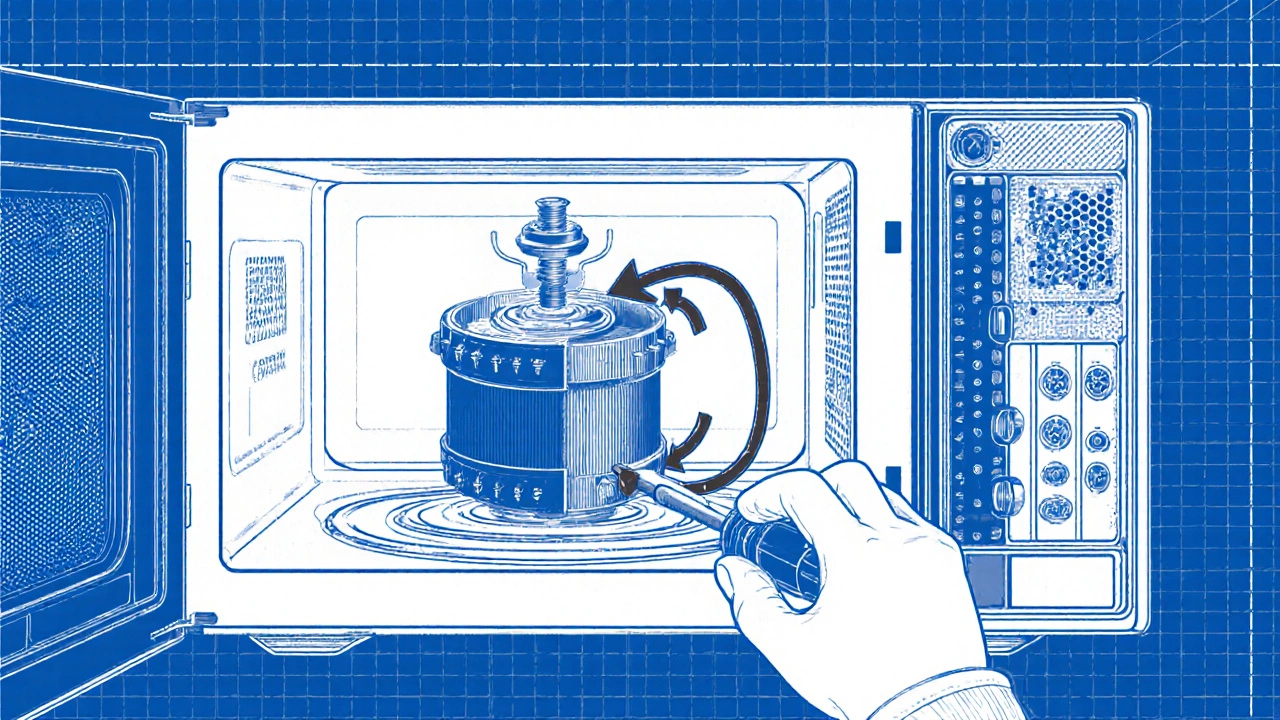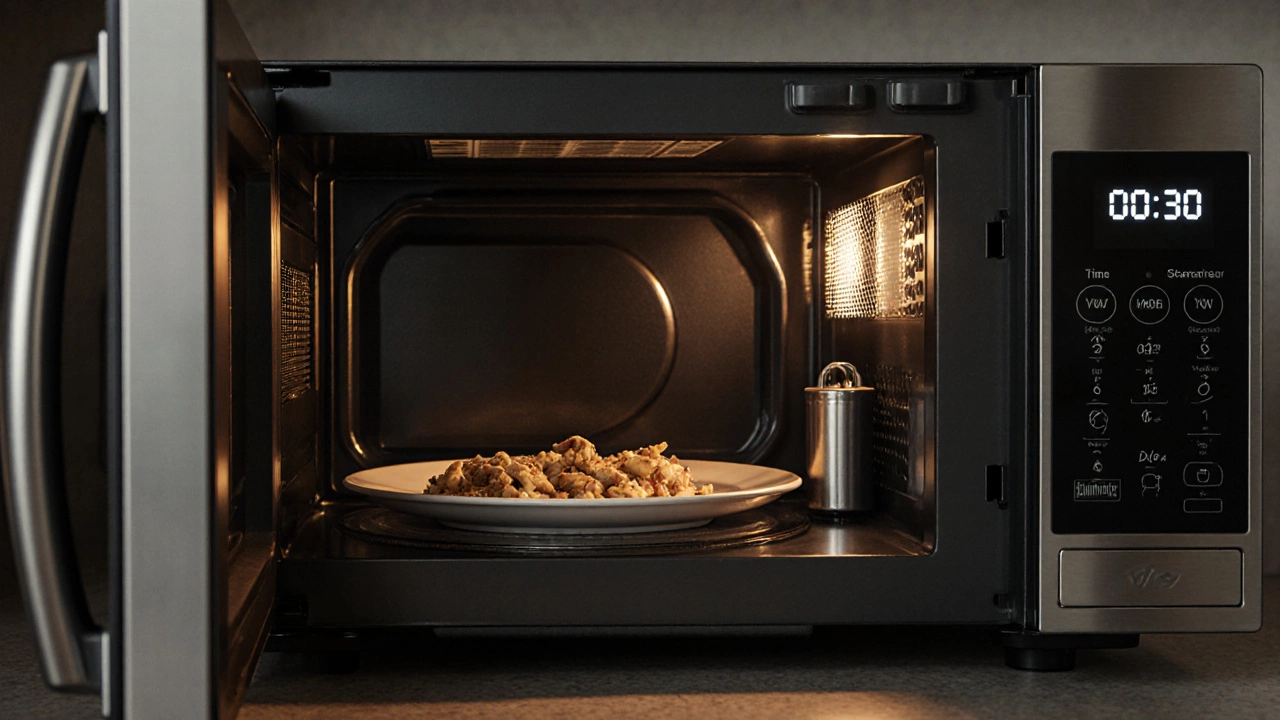MicroWave Magnetron Diagnostic Tool
Select all symptoms your microwave is showing. This tool will help you determine if a bad magnetron is the likely cause of your issue.
When a microwave suddenly refuses to heat your leftovers, the first thought is usually a blown fuse or a broken turntable motor. In reality, the most common culprit is the magnetron the high‑power vacuum tube that generates the microwaves inside the oven. Recognizing the specific signs of a failing magnetron saves you time, money, and a lot of guesswork.
Quick Overview: How a Microwave Generates Heat
A microwave oven is essentially a sealed metal box with three key power components: a high voltage transformer steps up the mains voltage to around 2,000 volts for the magnetron, a capacitor stores the high‑voltage charge and releases it in short bursts to the magnetron, and the magnetron itself, which converts that electrical energy into 2.45GHz microwave radiation. The waves travel through a waveguide a metal channel that directs the microwaves toward the cooking chamber and bounce around until they’re absorbed by food.
Top 7 Symptoms of a Bad Magnetron
Below are the most common red flags that point directly at a magnetron problem. If you notice one or more, it’s time to dig deeper.
- No heating at all - the timer runs, lights work, but nothing gets hot.
- Uneven heating - hot spots in some areas while other spots stay cool.
- Loud humming or buzzing - a higher‑pitched, continuous noise that’s louder than normal.
- Sparks or arcing inside the cavity - visible flashes or a crackling sound during operation.
- Burning or metallic smell - a faint ozone or scorched smell that lingers after the cycle.
- Internal light stays off - the oven’s interior bulb never illuminates, even when the door is open.
- Fault codes on the display - many modern units show an error like “F4” or “E1” which manufacturers link to magnetron failure.
Distinguishing Magnetron Issues from Other Failures
Not every heating problem is a magnetron. Here’s how to separate the wheat from the chaff.
- Transformer or capacitor failure - the oven may make a clicking sound but never produce a humming noise. A multimeter test of the high‑voltage coil usually shows open circuits.
- Door interlock or latch malfunction - the microwave won’t start at all, and you’ll see an error code related to the door interlock safety switches that prevent operation when the door is open.
- Waveguide cover damage - arcing often occurs when the metal waveguide cover is cracked or dirty, not necessarily a bad magnetron.
- Turntable motor issues - the motor can fail while the magnetron still works, leading to uneven heating but no loss of heat overall.
Simple Diagnostic Checks Before Calling a Pro
With the microwave unplugged and the capacitor safely discharged (use a screwdriver with an insulated handle to short the terminals), you can perform a few quick tests.
- Visual inspection: Look for blackening, bulging, or a faint glow on the magnetron’s ceramic envelope. Any discoloration is a strong sign of failure.
- Continuity test: Set a multimeter to ohms, touch the probes to the magnetron’s two terminals. A healthy magnetron typically shows low resistance (10‑30Ω). Infinite resistance means the filament is broken.
- High‑voltage diode test: While you’re inside, check the diode that works with the capacitor. A faulty diode can mimic magnetron symptoms.
If the magnetron fails the continuity test, replace it. If it passes, move on to the transformer or capacitor.
Safety First: Handling High‑Voltage Parts
Microwaves store up to 2,000V even after you yank the plug. Always discharge the capacitor before touching anything. Wear insulated gloves, keep a fire‑proof blanket handy, and work in a well‑ventilated area. If you feel unsure, it’s wise to call a certified technician.
When to Replace the Magnetron
Magnetrons are the costliest component in a microwave, typically ranging from $40USD to $120CAD in 2025. Consider replacement if:
- The oven is less than 7-10years old and you’ve verified the magnetron is the only faulty part.
- The fault codes point specifically to the magnetron (check the user manual for the model‑specific list).
- You’re comfortable soldering and re‑securing the high‑voltage connections.
Older units may be cheaper to replace entirely, especially if the cabinet is rusted or the door latch is worn.

Step‑by‑Step Magnetron Replacement Guide
Follow these steps only after you’ve disconnected power and discharged the capacitor.
- Remove the outer shell: Unscrew the four or six screws at the back and slide the top cover off.
- Locate the magnetron: It’s a cylindrical, metal‑cased component attached to the high‑voltage transformer via two thick black wires.
- Detach the wires: Use needle‑nose pliers to pull the connectors from the magnetron terminals. Note their orientation.
- Unscrew the mounting bracket: The magnetron is bolted to a metal bracket with two or three screws.
- Lift out the old magnetron: Gently wiggle it free; be careful not to damage the transformer or waveguide.
- Insert the new magnetron: Align the bolts and screws, then reconnect the high‑voltage wires exactly as they were.
- Reassemble the cabinet: Replace the top cover, tighten all screws, and plug the unit back in.
- Test the oven: Run a simple one‑minute cycle with a glass of water. If the water heats, you’ve fixed the problem.
Most homeowners finish this job in 30‑45minutes. If the microwave still won’t heat, re‑check the transformer and capacitor.
Quick Reference Table: Symptom vs Likely Cause
| Symptom | Most Likely Cause | Key Check |
|---|---|---|
| No heating | Bad magnetron | Continuity test on magnetron terminals |
| Humming but no heat | Faulty transformer or capacitor | Measure transformer resistance; check capacitor leakage |
| Sparking inside cavity | Damaged waveguide cover | Inspect waveguide for cracks or food buildup |
| Door won’t close or microwave won’t start | Door interlock switch | Test interlock continuity |
| Uneven heating | Turntable motor or rotating antenna failure | Check motor operation; listen for motor noise |
Frequently Asked Questions
How can I tell if the magnetron is physically burnt?
A burnt magnetron usually shows blackened or blistered ceramic on the tube, a faint metallic smell, or a visible crack in the glass envelope. Any discoloration means the tube needs replacement.
Can I use a multimeter to test a magnetron while it’s still wired?
Never test a magnetron under power. Unplug the unit, discharge the capacitor, then isolate the magnetron’s two leads. A low resistance reading (10‑30Ω) is normal; open circuit indicates a failed filament.
Is it safe to replace the magnetron myself?
If you’re comfortable working with high‑voltage components, have proper insulated tools, and follow the discharge procedure, the replacement is safe. Otherwise, hire a qualified technician to avoid electric shock or further damage.
How much does a new magnetron cost in 2025?
Retail prices range from $40USD for generic models to $120CAD for OEM parts from major brands. Shipping adds $5‑10CAD, and some retailers offer a two‑year warranty.
Will a faulty door latch cause the microwave to make a humming noise?
A door latch issue usually stops the microwave from starting at all. A persistent humming without heat points more toward transformer, capacitor, or magnetron problems.



